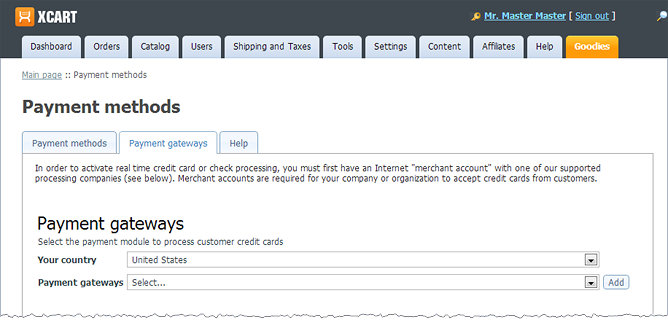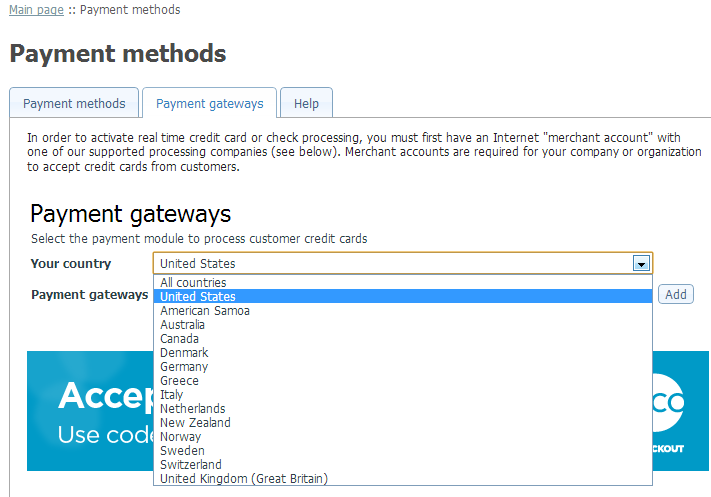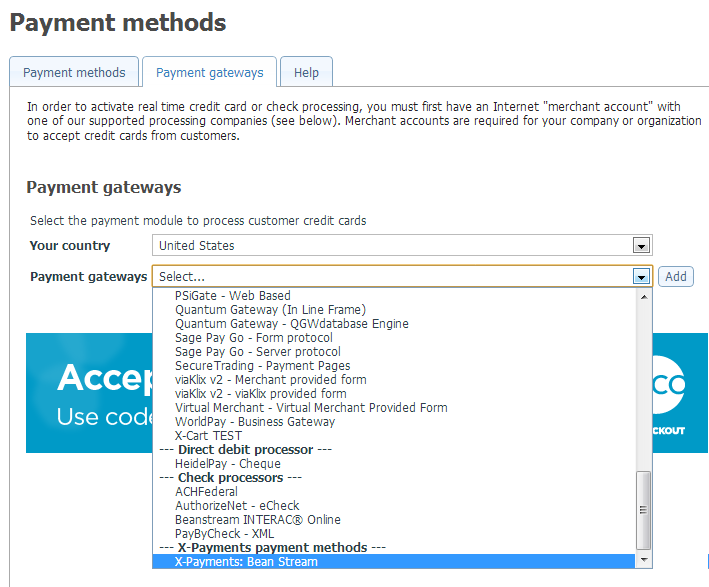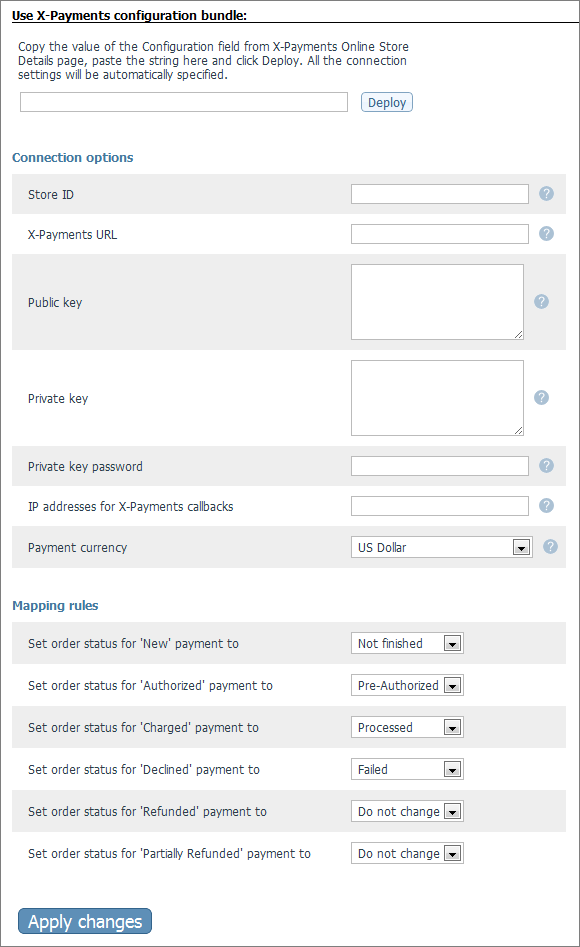X-Cart:X-Payments Connector
Contents
Overview
X-Payments Connector is an add-on module for X-Cart that provides an interface to connect X-Cart to X-Payments, a PA-DSS v 2.x verified payment application intended for web stores accepting online credit card payments through background payment gateways. See more about X-Payments at http://www.x-cart.com/extensions/modules/xpayments.html
Connecting an X-Cart store to X-Payments v2.1
Video tutorial
X-Payments 2.1.x and new X-Cart connector modules
In September 2014 we released new X-Payments connector modules for X-Cart 4.x Classic. See more at http://blog.x-cart.com/x-cart-4.x-connectors-for-xpayments-updated.html
Below is a video tutorial on how to connect X-Payments 2.1 with X-Cart 4.x Classic using the new connectors:
123 123
User manual for X-Payments v1.x and old X-Cart connector modules
IMPORTANT NOTE: If you use X-Cart newer than 4.6.3 and a new X-Payments version please read the above section.
Video tutorial
System requirements
To be able to use the X-Payments Connector add-on module, you must have:
- Installed copy of X-Cart v4.3.0 or later;
- Installed copy of X-Payments v 1.0 or later;
- PHP extensions:
- libCurl version >= 7.10;
- OpenSSL extension;
- XML DOM extension, to parse XML data (or DOM extension for PHP 5.x).
Configuring X-Payments Connector
Before you can start using X-Cart together with X-Payments, you must configure X-Payments Connector.
To configure X-Payments Connector:
1. Log in to the X-Cart Admin area.
2. Go to the Modules section (Administration menu -> Modules).
3. If not selected, select the check box for X-Payments Connector and click Update. This will activate the module.
4. Click on the Configure link for X-Payments Connector.
This will open the X-Payments Connector configuration page.
5. Define connection details.
- Copy the value of the Configuration bundle field from the X-Payments' Online Store Details page, paste the string here and click Deploy. All the connection settings will be automatically specified.
The latest versions of X-Payments Connector can automatically get connection settings from the settings of the store. In the older versions, the values are to be specified manually.
- Store ID: Unique value generated in the X-Payments back-end for a particular store. This value allows X-Payments to correctly identify requests coming from this store.
- X-Payment URL: The URL of your X-Payments installation. Make sure the URL is specified correctly, otherwise the module will not be able to connect to X-Payments.
- Encryption key: A key to encrypt requests that the store sends to X-Payments. The key is generated in the X-Payments back-end.
- Decryption key: A key to decrypt responses and callback requests that the store receives from X-Payments. The key is generated in the X-Payments back-end.
- Decryption key password: A password to decrypt the Decryption key. The password is generated in X-Payments back-office.
- IP addresses for X-Payments callbacks: enter IP address of the server where X-Payments is installed. "127.0.0.1" can not be used here. If you are using a hosted X-Payments plan read this FAQ. For better understanding what IP address to put here see X-Payments:How_It_Works#Callback_from_X-Payments_to_the_store
6. Establish mapping rules.
Mapping rules are used to synchronize transaction statuses in X-Payments with statuses of respective X-Cart orders. To associate an X-Payments transaction status with an X-Cart order status, choose the order status from the drop-down box in the column on the right.
For example, if you associate the entry "Set order status for 'Charged' payment to" on the right with the value "Processed" from the drop-down box on the left, changing the status of an X-Payment transaction to "Charged" will automatically change the status of the respective order in X-Cart to "Processed".
7. Click the Save button.
Making a test transaction
To test the module settings and connection with X-Payments click the Test module button. If the module is configured properly, a 'Test transaction successfully completed' message is displayed at the top of the page.
Importing X-Payments payment methods into X-Cart
To be able to use the payment methods defined in X-Payments you should import information about them from X-Payments.
First click the Request payment methods from X-Payments button, and X-Payments will return a list of payment methods available for this shopping cart.
After you have reviewed the list of available payment methods, click Import payment methods and proceed with the next step - adding and enabling X-Payments payment methods in X-Cart admin area.
Adding and enabling X-Payments payment methods in X-Cart
To be able to use X-Payments payment methods, you need to add and enable them in X-Cart admin area.
- In the Admin area of your X-Cart store, go to the Payment methods page (Settings->Payment methods).
- On the Payment methods page, click the Payment gateways tab to open the section where you select payment gateways:

- Use this section to select the payment methods you have configured in X-Payments:
First, choose your country of business from the Your country box to ensure that you see only payment gateways available for you country:
Then, choose the method you have imported from X-Payments from the list in the Payment gateways selector (Methods imported from X-Payments can be found under the X-Payments payment methods section title):
- Click Add. The payment method will be added.
Now, if you click the Payment methods tab, you will be able to see the newly added payment method in the Payment methods section:
You can check its configuration by clicking the Configure link opposite its name.
Note that for X-Payments payment methods it is not possible to change the configuration using X-Cart's user interface. Should you need to change anything, you will have to make the changes in X-Payments and then import and add the method in X-Cart again.
After the payment method has been added, you need to enable it:
- Locate the payment method you have added in the list of payment methods. You may need to scroll down the form because new methods are added to the end of the list.
- Select the check box to the left of the payment method name.
- Click Apply changes. The payment method will be activated.
You can edit or delete the added X-Payments payment method like any other payment methods in X-Cart.
Enabling iFrame support for One-Step-Checkout
An online store based on X-Cart version 4.1.9 (or later) and connected to X-Payments version 1.0.6 (or later) with one of the latest versions of the X-Payments connector can be configured to display the secure X-Payments generated form for entering payment card information directly on the checkout page in X-Cart - as opposed to the mode in which this form is displayed on a separate page. For the buyer everything looks as though they were entering their credit card details within your regular checkout routine. Embedding the form generated by X-Payments into X-Cart's checkout page is made possible by use of iFrame. iFrame integration for X-Cart&X-Payments checkout routines is part of the X-Payments connector functionality, so it is essential that you should use an up-to-date version of the connector to enjoy this feature. Older versions of the connector (released prior to September 2014) do not support the iFrame feature, so if you last updated your X-Payments connector for X-Cart prior to September 2014, or purchased your X-Cart prior to September 2014 and continue to use the built-in X-Payments connector that came with it, you must update your X-Payments connector be able to use the iFrame feature. Newer X-Payments connector versions (released after September 2014) already include support the iFrame feature, but we still recommend updating to the latest connector version available to ensure that your connector has all the latest features and fixes.
Steps to enable displaying the payment card form in iFrame:
- In your X-Cart store's Admin back end, go to the X-Cart Connector settings page and enable the "Use iframe" option (If you are using an older X-Cart versions, this may be called "Use lite interface").
- Make sure the "API version" field on the same page is set to "1.2".
- In your X-Payments Admin back end, go to the Online Store Details page for your store and enable the "lite" template there.
Here's also a video for how to enable the iFrame feature in X-Cart working with X-Payments:
|



